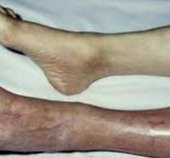Acute Limb Ischemia
Nicolas Smith, MS III
Definition
Ischemia is a term used to describe decreased blood flow to bodily tissues. This results in decreased oxygen delivery to the tissue, leading to damage and even tissue death. When ischemia happens very quickly and affects the blood vessels supplying an arm or a leg, it is called acute limb ischemia. Acute limb ischemia is a very serious medical problem that can cause loss of limb. It is very important to treat acute limb ischemia as soon as possible, so patients who believe they have acute limb ischemia should be evaluated emergently by a vascular specialist. Every minute matters! Treatment includes the use of both medications and surgical procedures.
Causes
Overwhelmingly, the most common causes of acute limb ischemia involve blockages of arteries that deliver blood to the limbs. Decreased blood flow results in decreased oxygen delivery to active tissues, leading to injury and tissue death. Many events can cause the blockage of an artery, with the most common causes discussed here:
Many physicians can diagnose acute limb ischemia simply by asking the patient questions about his or her symptoms and then performing a physical exam. Additional tests may be run to ensure that the correct diagnosis is made, including:
The treatment of acute limb ischemia is very complex. Physicians use many factors, including the severity of arterial blockage and the patient’s history, when deciding what treatment choice is best for each individual patient. Most patients will be treated with a combination of surgery and medications (such as heparin, a blood thinner). Many surgical strategies exist, and they can be combined to suit a patient’s individual needs. Patients who are treated for acute limb ischemia should been seen regularly by a vascular surgeon in office for the rest of their life.
Surgical strategies for treating acute limb ischemia include:
Go Back Ischemia is a term used to describe decreased blood flow to bodily tissues. This results in decreased oxygen delivery to the tissue, leading to damage and even tissue death. When ischemia happens very quickly and affects the blood vessels supplying an arm or a leg, it is called acute limb ischemia. Acute limb ischemia is a very serious medical problem that can cause loss of limb. It is very important to treat acute limb ischemia as soon as possible, so patients who believe they have acute limb ischemia should be evaluated emergently by a vascular specialist. Every minute matters! Treatment includes the use of both medications and surgical procedures.
Causes
Overwhelmingly, the most common causes of acute limb ischemia involve blockages of arteries that deliver blood to the limbs. Decreased blood flow results in decreased oxygen delivery to active tissues, leading to injury and tissue death. Many events can cause the blockage of an artery, with the most common causes discussed here:
- Arterial thrombosis: the formation of a clot within the arterial system itself. These clots are most likely to occur at the site of a pre-existing cholesterol (atherosclerotic) plaque. Clots can form at cholesterol plaques in two different ways. If the plaque becomes large enough, it may slow down blood flow to the point that clots are allowed to form. Alternatively, the plaque can rupture from within, leading to the formation of a clot. Other causes of arterial thrombosis include arterial aneurysm, arterial dissection, and hypercoagulable states.
- Embolism: a clot forms somewhere else in the body and is carried by blood flow to an artery, where it gets stuck. Arterial emboli typically form in the heart due to conditions such as atrial fibrillation. Arterial emboli most commonly affect the lower limbs.
- Injury: direct injury to an artery can cause the formation of a clot, blocking the artery. This most commonly occurs following posterior knee dislocation.
- Thrombosis following intervention: when a clot forms in an artery after a medical procedure, most commonly after stent or graft placement. This is a rare occurace, but still a cause of acute limb ischemia.
- Symptoms typically include:
- Pain
- Pale appearance of the limb
- The limb feels cold
- A change in sensation in the limb, often a “pins-and-needles” feeling
- aralysis of the limb
- Decreased strength in the limb
- Decreased pulses in the limb
Many physicians can diagnose acute limb ischemia simply by asking the patient questions about his or her symptoms and then performing a physical exam. Additional tests may be run to ensure that the correct diagnosis is made, including:
- Ankle-brachial index: blood pressures are taken in both arms and both legs and then compared. This can give the physician an idea of how much blood flow is reaching each limb.
- Imaging: depending on the severity of the limb ischemia, the physician may choose to order a medical imaging test, such as a CT scan, to try to find the cause of the limb ischemia.
The treatment of acute limb ischemia is very complex. Physicians use many factors, including the severity of arterial blockage and the patient’s history, when deciding what treatment choice is best for each individual patient. Most patients will be treated with a combination of surgery and medications (such as heparin, a blood thinner). Many surgical strategies exist, and they can be combined to suit a patient’s individual needs. Patients who are treated for acute limb ischemia should been seen regularly by a vascular surgeon in office for the rest of their life.
Surgical strategies for treating acute limb ischemia include:
- Catheter-based thromboembolectomy: the physician will insert a catheter into the artery and removes the obstruction
- Bypass grafting: the physician uses a graft to bypass the blockage so that blood can get to the limb tissues
- Thrombolytic therapy: the physician injects a drug onto the clot to dissolve it
- Percutaneous transluminal angioplasty: the physician uses a small, inflatable balloon to smash the obstruction and open the artery
- Limb amputation: if all other opttions have been explored, amputation may be necessary
